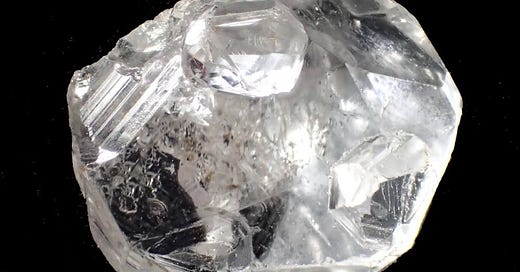Life in the USA is not normal. It feels pointless and trivial to be talking about small looks at the fascinating natural world when the country is being dismantled. But these posts will continue, as a statement of resistance. I hope you continue to enjoy and learn from them. Stand Up For Science!
This vitreous little crystal (16 mm wide) looks a lot like quartz, but it isn’t. It’s phenakite, whose name from Greek φέναξ, fenaks, means “deceiver” for its confusion with quartz. It has similar luster and crystallography, but it’s harder, close to 8 on the hardness scale vs 7 for quartz. And it’s simple beryllium silicate, Be2SiO4.
This one is gemmy enough to be cut into a gemstone, but not on my watch – I think it’s far more valuable in its natural state. I’m not 100% sure where this one is from, but Minas Gerais, Brazil, is the most likely locality. That doesn’t narrow it down much, because Minas Gerais is a vast province with exceptional mineral deposits. But the Rio Piracicaba area is famous for its phenakite and this one may well be from there. The phenakite at Rio Piracicaba is from small pegmatites associated regionally with extensive iron deposits of Precambrian age in highly deformed and metamorphosed rocks. Phenakite for gems was exploited in a small commercial way there in the 1960s and earlier.
Wherever it is from, this specimen would have been mined pre-1970, possibly quite a long time before then. It’s from the collection of my mineralogy professor, Carl W. Beck (1916-1971).
Phenakite was named by Finnish mineralogist Nils Gustaf Nordenskiöld (1792-1866) in 1834, based on specimens from the Urals in Russia (Beschreibung des Phenakits, eines neuen Minerals aus dem Ural: Annalen der Physik und Chemie, 107, 57-62). Although you sometimes see it spelled phenacite, it is pronounced with a hard “c,” as a “k” sound.




